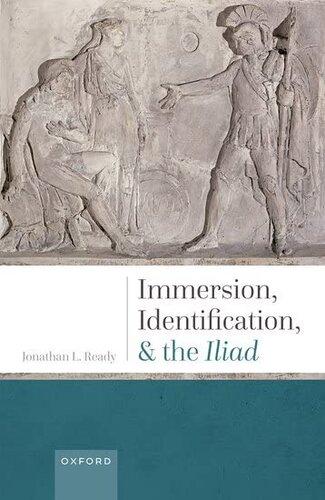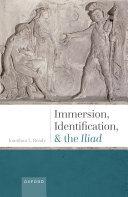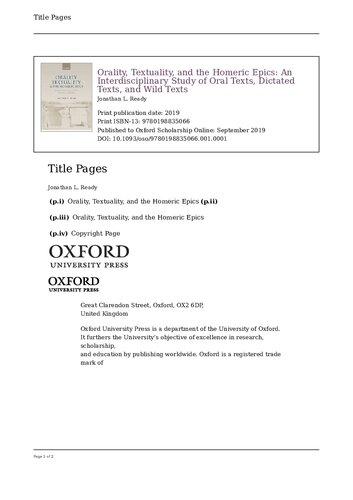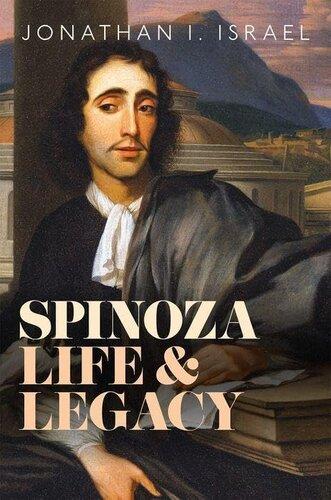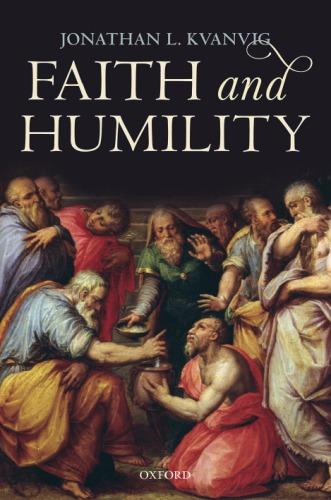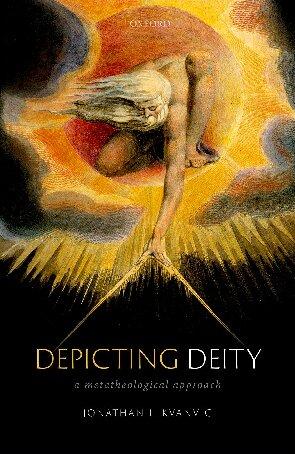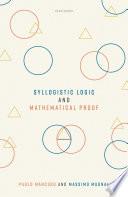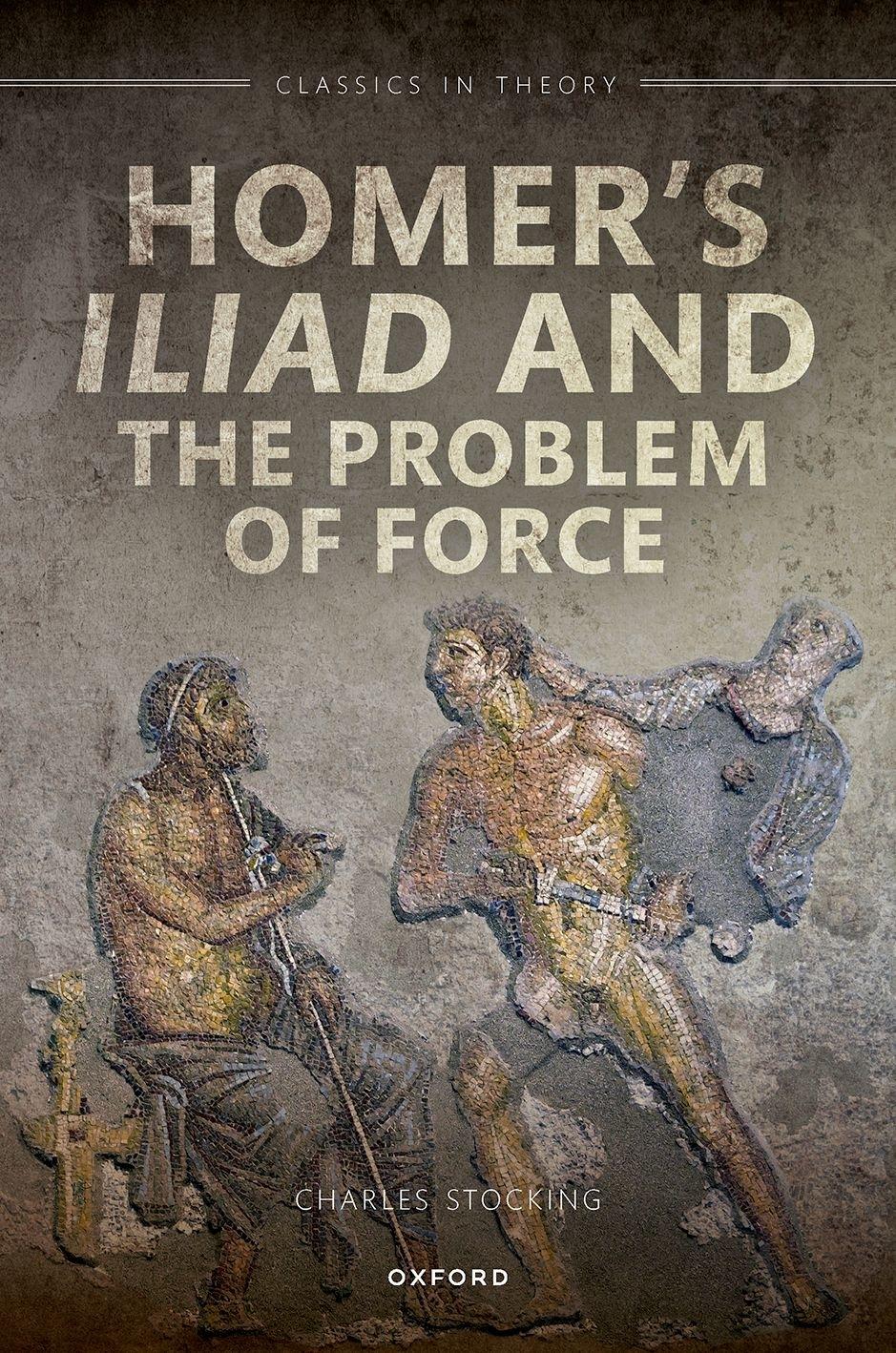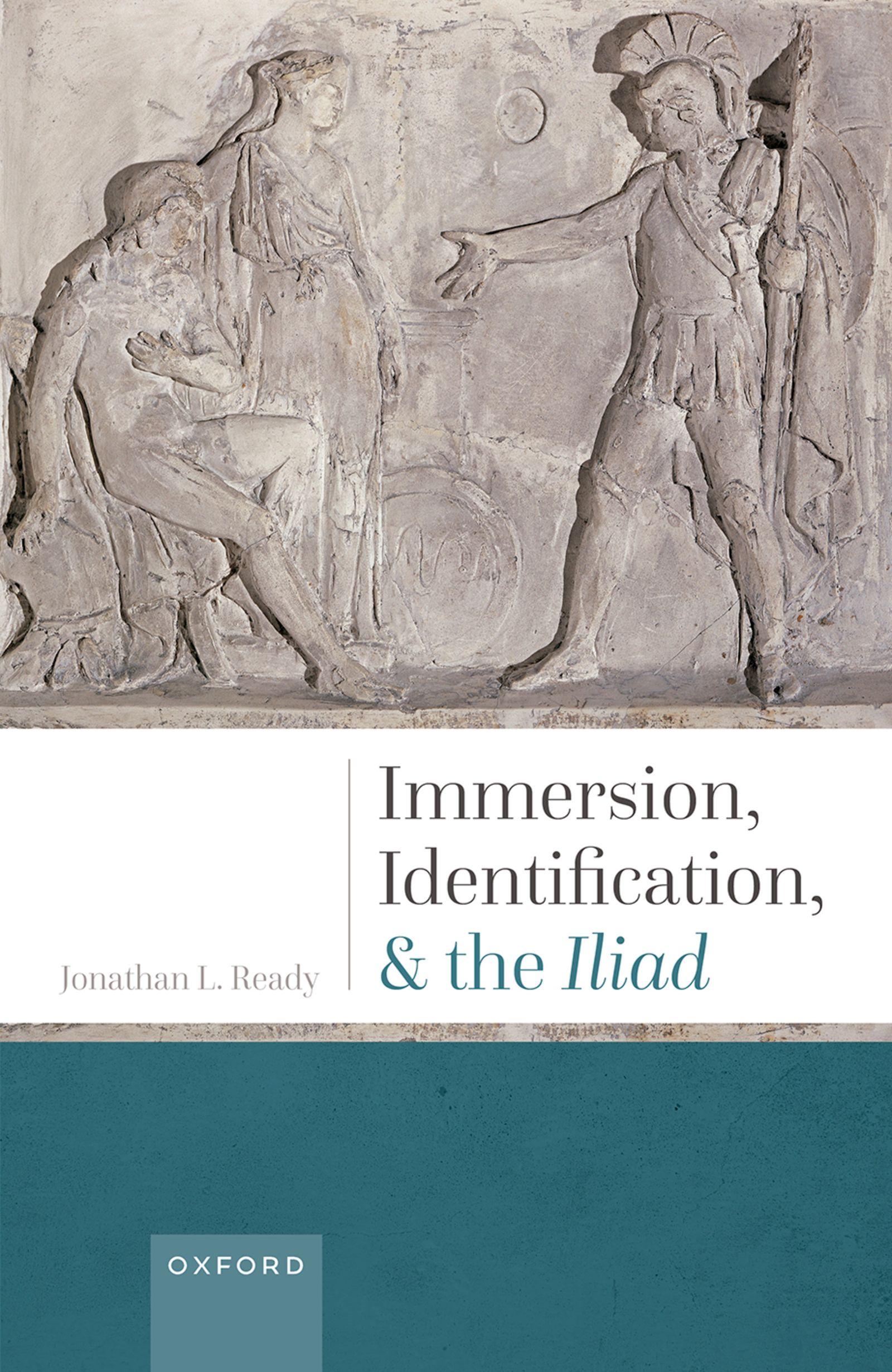Immersion, Identification, and the Iliad Prof Jonathan L. Ready Visit to download the full and correct content document: https://ebookmass.com/product/immersion-identification-and-the-iliad-prof-jonathan-l-r eady/
More products digital (pdf, epub, mobi) instant download maybe you interests ...
Immersion, Identification, and the Iliad Jonathan L.
Ready
https://ebookmass.com/product/immersion-identification-and-theiliad-jonathan-l-ready/
Orality, Textuality, and the Homeric Epics: An Interdisciplinary Study of Oral Texts, Dictated Texts, and Wild Texts Jonathan L Ready
https://ebookmass.com/product/orality-textuality-and-the-homericepics-an-interdisciplinary-study-of-oral-texts-dictated-textsand-wild-texts-jonathan-l-ready/
Spinoza, Life and Legacy. 1st Edition Prof Jonathan I.
Israel.
https://ebookmass.com/product/spinoza-life-and-legacy-1stedition-prof-jonathan-i-israel/
Faith and Humility Jonathan L Kvanvig
https://ebookmass.com/product/faith-and-humility-jonathan-lkvanvig/
Homer's Iliad and the Problem of Force Charles H.
Stocking
https://ebookmass.com/product/homers-iliad-and-the-problem-offorce-charles-h-stocking/
Choose Your Customer Jonathan L. S. Byrnes
https://ebookmass.com/product/choose-your-customer-jonathan-l-sbyrnes/
Depicting Deity: A Metatheological Approach Jonathan L. Kvanvig
https://ebookmass.com/product/depicting-deity-a-metatheologicalapproach-jonathan-l-kvanvig/
Syllogistic Logic and Mathematical Proof Prof Paolo. Mugnai Mancosu (Prof Massimo.)
https://ebookmass.com/product/syllogistic-logic-and-mathematicalproof-prof-paolo-mugnai-mancosu-prof-massimo/
Homer's Iliad and the Problem of Force Charles H.
Stocking
https://ebookmass.com/product/homers-iliad-and-the-problem-offorce-charles-h-stocking-2/
Immersion,Identification,andthe Iliad Immersion, Identification, andthe Iliad JONATHANL.READY GreatClarendonStreet,Oxford,OX26DP, UnitedKingdom
OxfordUniversityPressisadepartmentoftheUniversityofOxford. ItfurtherstheUniversity’sobjectiveofexcellenceinresearch,scholarship, andeducationbypublishingworldwide.Oxfordisaregisteredtrademarkof OxfordUniversityPressintheUKandincertainothercountries
©JonathanL.Ready2023
Themoralrightsoftheauthorhavebeenasserted Somerightsreserved.Nopartofthispublicationmaybereproduced,storedin aretrievalsystem,ortransmitted,inanyformorbyanymeans,forcommercialpurposes, withoutthepriorpermissioninwritingofOxfordUniversityPress,orasexpressly permittedbylaw,bylicenceorundertermsagreedwiththeappropriate reprographicsrightsorganization.
Thisisanopenaccesspublication,availableonlineanddistributedunderthetermsofa CreativeCommonsAttribution – NonCommercial – NoDerivatives4.0 Internationallicence(CCBY-NC-ND4.0),acopyofwhichisavailableat http://creativecommons.org/licenses/by-nc-nd/4.0/.
Enquiriesconcerningreproductionoutsidethescopeofthislicence shouldbesenttotheRightsDepartment,OxfordUniversityPress,attheaddressabove PublishedintheUnitedStatesofAmericabyOxfordUniversityPress 198MadisonAvenue,NewYork,NY10016,UnitedStatesofAmerica
BritishLibraryCataloguinginPublicationData Dataavailable
LibraryofCongressControlNumber:2022950545
ISBN978–0–19–287097–1 DOI:10.1093/oso/9780192870971.001.0001
PrintedandboundintheUKby ClaysLtd,ElcografS.p.A.
LinkstothirdpartywebsitesareprovidedbyOxfordingoodfaithand forinformationonly.Oxforddisclaimsanyresponsibilityforthematerials containedinanythirdpartywebsitereferencedinthiswork.
BridieRoseBridieRose BridieRose 1 καὶἐμέ. InscriptionesGraecae IV²2,757
Preface Welabel “multiplecorrespondencesimiles” thosesimilesthatlinkdifferent charactersorobjectsinthenarrativetodifferententitiesinthevignetteinthe simile’svehicleportion(the “ as ” portion).AjaxkillsSimoesiusasamanwho makeschariotscutsdownatreeinamarsh(Iliad 4.482–9).HectorawaitsAchilles asasnakeawaitsaman(Iliad 22.92–6).Thinkingabouthowthesesimilesworkin the Iliad requirestakingastepbacktothinkabouthowtheHomericpoetbrings characterstoourattentionandsetsthemaside.Thatsubjectdirectsoneinturnto thenumerousminorcharacterswhopopulatethepoemandwhoreflectthe challengesthepoetfacesinactivatinganddeactivatingcharacters.So,as I finishedupmydiscussionofmultiplecorrespondencesimiles(Ready2011: 220–58),Ibeganworkonwhateventuatedadecadelaterinanarticleonthe Iliad’sbitplayers(Ready2020).IthoughtIwouldusethatpieceasthestarting pointforabookonminorcharactersinancientGreekliterature.Ihadtucked awayina filingcabinetahardcopyofanoddpaperfromgraduateschoolabout minorcharactersinHerodotus’ s Histories:theexecutionleftmuchtobedesired, butthecorethesisseemedworthresuscitating.AsIcontinuedmysecondary readingoncharacters,Icameacrosstheliteratureonidentificationwith fictional characters.Thebibliographyonidentificationledmetotheliteratureonthestill largersubjectofimmersioninnarratives.
Itbecameclearthattherewasmorethanenoughtosayaboutimmersionand identificationinthecontextofHomericepicandthatIwouldhavetowaityet againtowriteonothergenres.IalsodiscoveredthatIhadunwittinglystumbled intoa fieldofinvestigation howrecipientsofnarrativesareimmersed thata numberofmycolleaguesinclassicalstudieshadjustbeguntowork.This fortuitousoccurrencewasthe firstsuchexperienceinmyscholarlycareer.My previousbookshaveaddressedHomericsimiles,thenatureandhistoryof Homerictexts,andearlyHomericpapyri allsubjectsoflong-standinginterest. Inthoseendeavors,Iofferednewinterpretationsofoldtopics.HereIintervenein discussionsthatclassicistsandHomeristshaveonlystartedtohaveabouthowthe Iliad’srecipients findthemselvesimmersedinthepoem.AnotherpointofdifferencebetweenthisbookandmypreviousworkisthathereIdonotconcernmyself untiltheendwiththecomplexrelationshipbetweenHomericpoetryandoral compositionandoralperformance.Iwillconfesstosomedegreeofreliefinthat regard:perhapsthisiswhatitfeelsliketoworkonGreektragedyorthepoetryof Vergilwhereobsessionsoverauthorship,performancecontext,andtext fixation donotrunonaneternalloop.Still,thereremainsanoticeablethroughline
runningbetweenthisbookandmy Orality,Textuality,andtheHomericEpics:An InterdisciplinaryStudyofOralTexts,DictatedTexts,andWildTexts (Ready 2019a).InPartsIIandIIIofthatbookandhereagainIseektoilluminatehow peopleinteract(ed)withandreact(ed)toHomericpoetry.
Asin TheHomericSimileinComparativePerspectives:OralTraditionsfromSaudi ArabiatoIndonesia (Ready2018)and Orality,Textuality,andtheHomericEpics, Iassembleandputtouseinthisbookanextensivebibliographyfromoutside classicalstudies.Iagainshowmyworkandintroducethereadertothismaterial withfrequentquotationsfromthatliterature.Itendtoavoidparaphraseinlieuof quotationlestIstrayfromtheprecisepointbeingmade.Iagainfollowthepracticeof fieldsoutsideofclassicalstudiesinlimitingthenumberoffootnotes.Forthemost part,Iincludecitationsinthemaintextin parenthesesinsteadofusingfootnotesfor citations:byvirtueoftheirplacementatthebottomofthepageandtheirsmallerfont size,footnotesalwaystosomedegreeoccludetheactualworkonecites.Ido acquiescetothemoreusualpracticeinclassicalstudiesbydeployingfootnotesfor citationalchainscomprisingsixormorereferences.Boththequotationandthe mannerofcitationaremywayofacknowledgingthedegreetowhichIdependon previousscholarshipandmywayofarticulatingtheimportanceofgroupeffortsin advancingscholarship.Onlyahandfulofdiscursivefootnotesappear.Ifapointis worthmaking,itshouldmeritinclusioninthemaintext,andasareaderI findit hardtofollowtheargumentinthemaintextifIamsupposedtotakebreaksalong thewaytoreadparagraph-longfootnoteswiththeirownarguments.
Onacoupleofoccasionsinthisbookaswell,Iwrite “Iliad” and “Odyssey” in romanfont(seeReady2019a:viii).Withthatformatting,Irefertoatraditionof oralperformanceinwhichperformerspresentwhattheythinkofasthesame story. Iliad and Odyssey initalicsrefertothewrittentextsweuse.
Quotationsfromthe Iliad comefromHelmutvanThiel’s2010edition,and quotationsfromthe Odyssey comefromvanThiel’s1991edition.Idonot reproducehislunatesigmas.Inotetheeditorsofotherancientworksonlyif Iquote,andonlywhenI firstquote,fromtheireditions.Alltranslationsaremy ownunlessotherwisenoted.
Referencestocurrenteventsinscholarshipofthissortagebadly.Butsurelyan exceptioncanbemadeforaonceinacenturyglobalpandemic.Ontheonehand, ithasbeenstrangetowriteabookaboutimmersionandidentification essentiallyabookaboutconnecting(orseemingtoconnect)withotherpeople andotherplaces whenonecannotshareaphysicalspaceexceptwiththosein one ’sbubbleandcannotgoanywhere.Ontheotherhand,ifeverpeoplehave cometoappreciatetheirdegreeofimmersioninstoryworldsandofidentification withcharacters,nowmightbethattime.Idonothavetherequisitedistancefrom thisprojecttodeterminehowthosetwofactorshaveshapedit.Oncethisvolume hasbeenabsorbedandisnolongercitedperhapsitwillhaveasecondlifeasa specimenofCOVID-19-erascholarship.
Acknowledgments IthankFritzBreithaupt,RuthScodel,andChristosTsagalisforconversationand correspondenceatvariousstagesofthisproject.InDecember2019,audiencesin Heidelberg,Rethymnon,andThessalonikihelpedmeclarifymythoughtson identificationasdidthesummer2021fellowsoftheUniversityofMichigan ’ s InstitutefortheHumanities.IamgratefultothePress’stwoanonymousreaders fortheircarefulattentiontothemanuscript,and,onceagain,IthankCharlotte LoveridgeandtheentireteamatthePressfortheirskillfulwork.Asever,Iam indebtedtoMargaretFosterforherguidanceandsupport.
Thisbookisfreelyavailableinanopen-accesseditionthankstoTOME (TowardanOpenMonographEcosystem) acollaborationoftheAssociation ofAmericanUniversities,theAssociationofUniversityPresses,andthe AssociationofResearchLibraries andthegeneroussupportoftheUniversity ofMichigan’sCollegeofLiterature,Science,andtheArtsandOfficeofthe Provost.LearnmoreattheTOMEwebsite,availableat:openmonographs.org. TheDepartmentofClassicalStudiesattheUniversityofMichiganalsocontributedthroughitsFrierFundtosupporttheopen-accesspublicationofthisbook.
1.Introduction1
1.1.Overview1
1.2.Terminology1
1.3.PreviousScholarship3
1.4.OutlineofChapters10
PARTI:IDENTIFICATIONANDTHE ILIAD 2.TheStudyofIdentification15 2.1.Overview15
2.2.TheComponentsofIdentification16
2.3.TheTriggersforIdentification28
2.4.AncientPrecedentsforaStudyofIdentification34
2.5.CharacterandEmotionalIdentification45
2.6.Conclusion51
3.Promptsfor(aStudyof)IdentifyingwithCharacters53 3.1.Overview53
3.2.RecurringFeatures53
3.3.InternalNarratorsandIdentification62
3.3.1.AgamemnononTydeus65
3.3.2.NestoronNestor71
3.4.Conclusion81
4.IdentificationwithMortalsandGods83
4.1.Overview83
4.2.IdentificationwithMortals83
4.2.1.Agamemnonin Iliad 1183
4.2.2.Andromachein Iliad 2294
4.2.3.TheFuneralGamesin Iliad 23100
4.2.4.Priamin Iliad 24110
4.3.IdentificationwithGods113
4.3.1.The HomericHymntoDemeter 115
4.3.2.Herain Iliad 14118
4.3.3.Thetisin Iliad 18121
4.4.LimitstoIdentification127
4.5.ThePoliticsofIdenti fication131
4.6.Conclusion142
PARTII:IMMERSIONANDTHE ILIAD 5.AncientsandModernsonImmersion147
5.1.Overview147
5.2.AncientPrecedentsforaStudyofImmersion147
5.3.ModernStudiesofImmersion154
5.4.Conclusion158
6.SpatialandSpatio-TemporalImmersion159
6.1.Overview159
6.2.SpatialImmersion159
6.3.Spatio-TemporalImmersion173
6.4.Conclusion193
7.EmotionalImmersion195
7.1.Overview195
7.2.Suspense196
7.3.OtherEmotions211
7.4.Conclusion220
8.ContentandForm221
8.1.Overview221
8.2.InnerLife221
8.3.Ourselves225
8.4.FormalFeatures230
8.5.Conclusion236
9.Conclusion239 WorksCited
Introduction 1.1.Overview Section1.2offersdefinitionsofnarrative,storyworld,immersion,identi fication, andrecipient.Section1.3orientsthisinvestigationofHomericimmersionand identificationinrelationtopriorscholarshipinHomericstudies.Section1.4 providesabriefoutlineofthefollowingchapters.
1.2.Terminology Istartwithsomefraughtdefinitions.Wewillbetalkingaboutnarrative,atricky termtodefineandonethatweperhapswanttobecarefulnottodefinetoo narrowly(Ryan2007).JonasGrethleinpositsthatanarrativeis “therepresentationofatemporalsequenceinvolvinghumanorhuman-likecharactersina sequentialmedium” (2017a:34;cf.Grethlein,Huitink,andTagliabue2020:8). JohnFrowgoesintoabitmoredetail,discerningthreeessentialcomponentsofa narrative(2018:106):
amediumofrepresentation...;aspeakingvoice,orsomecorrespondingenunciativemoment(thecompositegazethroughwhichweviewa film,forexample), whichactivatesthatmedium;andthemovementofpersons,orquasi-persons, throughspaceandtimeandrelationshipsinarepresentedworld.
Butthereareotherwaystothinkabouttheterm.FritzBreithauptproposesthata narrativeisanaccountthataudiencesunderstandasonepossibleversionofwhat happened(2011,esp.109,120).
Letusmoveontoworkingdefinitionsofstoryworld,immersion,andidentification.Wehavegeneralagreementonadefinitionofstoryworld: “Thestoryworld hastwocomponents.First,thereisthesetting,theplaceandtimeinwhichthe eventsoccur.Second,therearecharacters,thehumanornon-humanagentsthat initiateorexperienceevents” (Hogan2018:133);storyworldsare “totalitiesthat encompassspace,time,andindividuatedexistentsthatundergotransformations astheresultofevents” (Ryan2019:63).Immersedrecipientsgetwrappedup inanarrativeandthestoryworlditdepictsandlosetracktosomedegreeoftheir
Immersion,Identification,andthe Iliad.JonathanL.Ready,OxfordUniversityPress.©JonathanL.Ready2023. DOI:10.1093/oso/9780192870971.003.0001
real-worldsurroundings.Identi ficationoccurswhenrecipientsinterpretthestoryworldfromacharacter’sperspective,feelacharacter’semotionsoratleast emotionscongruentwiththoseofthecharacter,and/orrootforacharacterto succeed.Iwillgointothecomponentsofimmersionandidentificationinmuch greaterdetailoverthecourseofthisbook.
Adoptingthesethreedefinitionsandutilizingthesethreeconceptsisalreadyto makechoices,totakeastand,andtomaneuvercarefullybetweenopposed scholarlypositions.Forinstance,Marie-LaureRyanaimstorebutRichard Walsh’sassertions(2017)thattheconceptsofworldandimmersionarenotuseful forthestudyof fictionalnarrative(2018:236–7).Notetoothatmediascholars haveappliedtheterm “immersion” toarangeofphenomenaandexperiences (Nilsson,Nordahl,andSerafin2016)orthatmanypreferadifferentwordentirely, speakingofabsorption,aestheticillusion,enchantment,engagement,engrossment,entanglement,involvement,ortransportation.Or,asa finalexample, observethehedgeinmyformulation “thecharacter’semotions oratleast emotionscongruentwiththoseofthecharacter,” aresponsetoadisputeoverthe natureofouremotionalengagementwithcharacters(seesection2.5,pp.49–50).
Lessfraughtbutworthexplicitconsiderationisthefollowing.Recipientsrespond differentlyto fictionalandnonfictionalnarratives(e.g.,Vaage2016:26–34),but whetheranarrativeis fictionornonfictionisirrelevantwhenitcomestothesethree concepts.Whereasmuchoftheliteratureonstoryworlds,immersion,andidentificationpertainsto fictionalnarrative,itisalsotruethatwecanspeakofnonfiction storyworlds,beimmersedinnonfictionstoryworlds,andidentifywiththecharactersinnonfictionstoryworlds.¹ImakethispointbecauseIwanttoforestallan objectiontomyuseoftheseconceptsbythosewhothinkthatHomericpoetryisnot fiction(seesection2.4,p.34).Thedebateoverthe fictionalornonfictionalstatusof Homericepicdoesnotaffectthisproject(cf.Scodel2021:56–7).
Finally,Ihighlighthereatthestarthowtheword “recipient” thatIhavealready usedseveraltimescontributestothepresentation.Ithelpsoneavoidthecumbersomephrase “hearer,viewer,orreader,” but,moreimportant,itscapaciousness signalsmyconcernwithfeaturesofimmersionandidentificationthatdonot dependonaspecificmedium.Nodoubtthenatureofimmersionandidentificationvarydependingonmedia(e.g.,Grethlein2017a),butItargetcomponents ofthoseexperiencesthatarisewhetheroneiswatching,reading,orlisteningtoa tale(e.g.,Carpenter,Green,andFitzgerald2018:231;cf.Budelmann2000:15–16; Lovatt2013:21).OnlyinChapter9doIponderhowlisteningtoandwatching anoralperformerofHomericepicshapedtheaudience’sexperienceofthe storyworld.
¹Chen,Bell,andTaylor2016;2017;FitzgeraldandGreen2017:56;Roberts2018;R.Allan2019b; 2020;Ryan2019:62–3,66;AlamandSo2020;Fernandez-Quintanilla2020;Maloney2020;Tyrell2020: 48;Grethlein2021a:49,55–6,264;GoffinandFriend2022:135.
1.3.PreviousScholarship A1947articlein ClassicalJournal concludeswithachartpurportingtoshowhow theaudienceexperiencesvaryingdegreesofemotionalintensityoverthecourse ofthe Iliad (Ingalls1947).ThemajorityofHomericscholarshipinthesecondhalfof thetwentiethcenturyhadconcernsotherthanthinkingabouttheaffectivedynamicsofthepresentation.Withattentiondirectedtohowandwhenthe Iliad andthe Odyssey werecomposed,energywentintodetermininghowbesttointerpretthem inlightofthosecompositionalmechanisms(cf.Hutchinson2017:145).Eventhose whodidnotworrysomuchaboutthegenesisofthepoemssawtheirjobasasking afterthemeaning(s)orargument(s)ofthepoems(e.g.,Redfield1975:ix).
Occasionally,explorationsofwhatcriticstermed “pathos” appeared some longer(e.g.,M.Scott1974;Griffin1980,esp.104–5),someshorter(e.g.,Glenn 1971:170;MartinMueller2009[1985]:e.g.,55;Davies2002:29).Suspense receivedafairamountofattentiontoo(Rengakos1999;cf.Liotsakis2021:6), andElizabethMinchinconsideredsomeotherwaysthe Iliad poetsought “tokeep usinvolvedinhistale” (1999:64).Typically,however,scholarlyprotocolsallowed foronlybriefacknowledgmentsoftheexperienceofhearingorreadingthe Iliad andthe Odyssey andoftheimpactthepoemscanhaveonrecipients.Forexample, the Iliad poet’sdetaileddescriptionsofhorrificwoundssuggestthat “heandhis audienceenjoythesceneenormously,” andthevarietyinthesedescriptions “ never boresus” (E.Vermeule1979:96–7).Inmomentsofembeddedfocalization the narratorgrantsaccesstoacharacter’spointofvieweventhoughthecharacterisnot talking—“theaudienceisbroughtintoaclosersympathywiththecharacter,and henceintocloseremotionalinvolvementwiththetale” (Edwards1991:4;cf.2002: 36).AninvestigationofTrojanpoliticsstartsfromtheobservationthatthepoet wantsaudiencestosympathizewiththeTrojans(Sale1994:7–13).Whenthe Odyssey poet “transformsfolkloreandanecdote,” heproduces “situationsofprofoundhumanmeaningthatleadusbacktothepoemagainandagain” (Segal1994: 194).Achillesundergoes “anevolutioninhischaracterwhichisbrilliantlyconceived,intuitivelyplausible,andprofoundlytragic” (Most2003:75).JamesRedfield relegatespersonalreflectionstotheprefaceofhisbookonHector(1975:ix,xii):
Thepresentbookthusgrewoutofaninterestin,andevenperhapsan identificationwith,onehero ....I developedtheanalysisbecauseIcareabout the Iliad ....Wecarrywithusinoursolitudethese fictionsthepoetshaveleftus, webroodovertheirmeanings,feeljoyandsorrowattheevents,makeofthe charactersourfriendsandenemies,and findourselvessomehownourishedby theexperience.
Conversely,NancyFelsonsavesforthepenultimatepageofherbookonthe Odyssey thefollowingcomment: “Iconcludebydepictingtheeventsthatoccur whenI asareader envisiontheactionofthepoem....Iamlulledtosilentaweand
complacentsatisfactionthatthecharacterswhohavebecomemycompanions have finallyreachedhome....Aprovisionalsatisfactionovercomesme... ” (1994: 143,emphasisinoriginal).The finalsentenceofLeonardMuellner’s1996bookon themeaningof mēnis alsostandsapartintenorandpointfromwhatcomes before: “Achillesbequeathstoustheself-perpetuatingartisticrepresentationofan idealistic,disturbing,andconsolingdefinitionofthehumancondition” (175).
Aristotle’sattentioninhis Poetics topity,fear,andcatharsisasessential componentsoftheaudience’sreactiontoGreektragedycreatedapermission structurefortwentieth-centuryscholarshipinthatsubfieldtoattendtothe audience’saffectiveengagement,discussionsthatpointupbywayofcontrast thegeneralocclusionofsuchmattersinHomericstudies.²ButHomericstudies hadgoodcompany:wittinglyornot,itjoinedotherbranchesofliterarystudiesin limiting,evensuppressing,ifnotexiling,discussionsofhowreadersrespond, especiallyemotionally,toandbecomeimmersedinnarratives.³
Fittingly,then,weweretoldthattoconsideraudienceresponsetotheHomeric epicsproperlyoneshouldaskafterthe “assumptionsandresponseswhichthe worksthemselvesseemtoexpect” asopposedto “theassumptionsandresponses whichwe,ascontemporaryreaders,tendtoprovide” (Gill1990:8).Ourown reactionsaretobesegregatedandthen(presumably)ignored.Oronecould recognizethatthecharactersprompt “oursympatheticinterest” (Gill2002:97), our “sympatheticengagement” (99),and “oursympatheticinvolvement” (105), butthisconnectionarisesasaresultof(“isareflectionof” (105), “inheresin” (152))thecarefulandrigorousintellectualanalysisthattheycompelusto perform:webecome “engagedintheirreasoning ” (117;cf.105,152,172–3)as theywrestlewith “certainfundamentalissuesofhumanlife” (119)and “withthe questionsor ‘problems’ whichthepoemasawholeexplores” (97;cf.173). Aclinical,rationalengagementisallowed.Thosemorewillingtoexplorehow theepicsgeneratearangeofaffectivedynamicsoftenviewedsuchdynamicswith suspicion.ConsiderLillianDoherty’sassessmentoftheendofthe Odyssey: “Ihave notstoppedtakingpleasureinthereunionofOdysseusandPenelope;rather,my pleasurehasbecomeinfusedwithanawarenessthatitinvitesmetobereconciled toanandrocentricviewoftheworld,aviewinwhichPenelope’shappinessis subordinatetoandindeeddefinedbythatofOdysseus” (1995:40;cf.192).
Inkeepingwithbroadertrendsinsideandoutsideofclassicalstudies,⁴ priorities haveshiftedinthesubfieldofHomericstudies.JonHeskasksustoconfront “the
²E.g.,Stanford1983;Heath1987;Griffin1998:54–61;1999:91–2;Griffith1999b:e.g.,43; Budelmann2000:e.g.,23,91;cf.Wohl2015:12,168n.6.
³M.Smith1995:188–9;Robinson2005:143;Davis2007:20;Felski2008:54;2015:12–13,54; 2020b:30,62;Ryan2015a:107;Grethlein2017a:4,123;2021a:154;2021b:228;Douglass2018:112; Hogan2018:4;Plantinga2018:211;KuzmičováandBálint2019:430;Knox2021:12;cf.Sedgwick 2003:144,150.
⁴ Inside:e.g.,Wohl2015:28,106–9,135–6;CairnsandNelis2017:10–11;Olsen2017;Meineck 2018;Weiss2020:333;deBakker,vanderBerg,andKlooster2022:10–15.Outside:e.g.,Robinson 2005;Plantinga2009;Hogan2018;Grethlein2021a:103.
difficultissueoftheaudience’spleasure” andhowthe Iliad “deliver[s]prurient thrillsandentertainingformsofterror” (2013:33;cf.43).LynnKozak’ s ExperiencingHektor exploreshowandwhy “the Iliad hascaughtmewithits Hektor” (2017:1) thatis,howandwhythepoemenablesaudiencemembersto connectwithandcareaboutitscharactersandengagewiththetalemoregenerally.Kozakattendstoanumberoffactorsthatbring “pleasure” torecipients,from achallengetotheirexpectations(119),toaresolutionofastoryline(121),toa “callback” (cross-reference)toanearlierepisode(130),totheirrecognizingthe typicalpatternofabattlescene(137).KozakintroducestoHomericstudies thenotionof “allegiance” whereinrecipientsjudgethecharactersandexperience likeordislikeasaresult(5–6,8;cf.section7.3,p.211).Thisexperienceisone manifestationofour “engagement” withthecharacters(62,111,157;cf.22).They alsodeploythenotionof “melodramaticalignmentstructure” whereinrecipients “knowmorethananyonecharacterknows” (6;cf.,e.g.,Rengakos1999:323on dramaticirony).Thisknowledge “increasesemotionalinvestmentandanticipationoftheeventstocome” (Kozak2017:92;cf.100,137–8,140–1,151,170,198). AndKozaktracesstillotherwaysinwhichthepoembuildsanticipation,suspense, curiosity,andevenanxietyinitsaudience(8–9,27,29,31,82,95,102,115, 143,147,195,218).Focusingonthe Iliad’sdivineapparatus,TobiasMyers queries “theemotionalimpact[ontheaudience]ofthedevastationatTroy,” “theintensityoftheir[theaudiencemembers]experienceastheylistento thetelling,” andhow “thepoetunderstandshimselftobehookinghislisteners” (2019:3,33,175).Hewrites, “Whilethe Iliad respondswonderfullytoanalysis, itisaimednotatanalyticalcriticsbutataudiencesreadytobesweptawayby wonder,pleasure,terror,andtears” (59;cf.91,93).Atthesametime,Myers argues,the Iliad poeturgeshisaudiencetoconsidertheiremotionalreactionsto thetale(124,210).RachelLesserdiscernsatriadofdesiresfeltbythe Iliad’ s audience(2022,esp.12–22).Theyexperiencenarrativedesire(wantingtolearn howthestorywillturnout),sympatheticdesire(feelingforacharacterandhoping allgoeswellforthem),andempatheticdesire(takingonacharacter’ s “ urges, wishes,andlongings” (18)).Theaudiencecansympathizeandempathizewitha rangeofcharacters Chryses,Achilles,Hera,Helen,Menelaus,Agamemnon, Odysseus,Andromache,Patroclus,Priam,Hecuba;theycansympathizeand empathizewithaspecificcharacteratonemomentbutnotatanother(178,189, 213,228).Sympatheticandempatheticdesirescangohandinhandwithandeven enhancenarrativedesire(21,30,107,189,195,200,203,215,221,229,241),or theycanconflictwithit,causingattimesfeelingsofdissonanceorevendread (99,128,153,178,181,199,215).LiberatingtooisJoelChristensen’sstudyofthe therapeuticworkafforded(ornot)bystorytellingtothecharactersandexternal audiencesofthe Odyssey (2020;cf.Grethlein2017b:118,271–82).Homerists, then,haveansweredGregoryHutchinson’scallfor “thinkingmoreabouthowthe poemaffectedlisteners” (2017:168).
Thisbookbuildsontheseinterventionsaswellasonadditionalscholarshipby investigatorsoftheancientworld bothinGreekstudiesandRomanstudiesand inbiblicalstudies thatstartsfromtwofactsnowwell-establishedindisciplines outsideclassicalstudiesdevotedtotheexplorationofnarrative.Whenpeopleread astoryorwhentheywatchaplay,movie,ortelevisionshow,many findthemselvesimmersedinthetaleanditsworldandmanyidentifywiththecharacters (cf.deBakker,vanderBerg,andKlooster2022:15–17).Morethanthat,many consumemediainordertoimmersethemselvesinthetaleanditsworldandto identifywiththecharacters:they “choose” and “allow” themselvestheseexperiences(Plantinga2018:195,249)and “strivetobeovercomebytheobjectsoftheir passion” (Felski2020b:65).Wecanshiftprioritiesandthinkaboutnarrativesas morethanaseriesofpuzzlesforthecritictosolve.
Onecan findthesepropositionsintraditionalsitesofliterarycriticism.From herperchinEnglish,forexample,RitaFelskipointstothenecessityoftaking seriouslythemajorityofreaderswhoreadinanapparently “unseemlyorinappropriatefashion identifyingwithcharacters,becomingabsorbedinnarratives, beingstruckbymomentsofrecognition ” (2015:29;cf.191;2008:14,17–18; 2020b:25;Moi2019:59).Wecritics,shewrites,shouldovercomeourfear “of beingcontaminatedandanimatedbythewordsweencounter” (2015:12),and whereasourtrainingpromptsustoaskcolleagues, “‘Butwhataboutpower?’ , ” we shouldnowask, “‘Butwhataboutlove?’ Or: ‘Whereisyourtheoryofattachment?’” (17–18).DrawingespeciallyonBrunoLatour’sactor-networktheoryto arguethattexts “makethingshappen” (168,180;cf.2020b:21–4),Felskiproposes a “postcriticalreading.” Thisapproach “treat[s]experiencesofengagement,wonder,orabsorptionnotassignsofnaïvetéorusererrorbutascluestowhyweare drawntoartinthe firstplace” (2015:180).Itasks, “Howdoworksofartmoveus, andwhy?Arecertainfeaturesoftextsmorelikelytotriggerempathyorrecognition,absorptionordisorientation?Whatdoesitmeantotalkaboutidentifying withacharacter?” (181;cf.AnkerandFelski2017;Felski2020a).
Felski’scleararticulationsofthematterathandandofitsstakesinspire (cf.Docherty2021),butIconcentrateforthemostpartonotherresearchin communications,literarystudies,mediastudies,andpsychologythatprovides accessibleandprecisedefinitionsandmodelsofimmersionandidentificationas wellasactionable findingsonhowimmersionandidentificationcomeabout.This projectrepresentsthe firstbook-lengthapplicationofthatresearchtothe Iliad.It therebyhelpsexplainwhypeoplecareaboutthisepicpoemanditscharacters(cf. B.Vermeule2010)andhowtheyactuallyrespondtothepoem.Putdifferently, thoseofusinHomericstudieswhowanttothinkaboutnarrativeimmersionand identificationshouldtakeasourguidesresearchersinthoseaforementioned fields whostudynarrativeimmersionandidentificationandespeciallythoseresearchers whodosoinanempiricalfashion.Byempirical,onereferstocontrolledexperimentswithresultssubjecttofalsi fication(HakemulderandvanPeer2016:192; differently,Margolin2008:9).
Tobesure,severalrelevantcontributionsinclassicalstudiesthataddressissues ofimmersionand/oridentificationdonotchoosethisroute.Studying “imagesof song ” foundwithintheHomericepics,StephenHalliwellnotesthepoems’ concernwithanaudience ’ s “intenseabsorption,”“raptconcentrationandengagement,” and “totalimmersion” (2011:45;cf.Liebert2017:48–62;Ready2018: 170–84;Giordano2022:177–83).Inanearlierintervention,Halliwelladdresses Plato’ s Republic:performersexperience “self-likening,absorption,andidentification” and “fullpsychologicalimmersion ” withcharacters(2002:54,79)whereas audiencemembersexperience “‘sympathy’ ratherthan ‘identification’” (81;cf. 93).NancyFelson’sinfluentialarticle, “VicariousTransport:FictiveDeixisin Pindar’ s Pythian Four,” finds “Pindarusesdeixiswithexpertiseandsubtlety, primarilytomakehisaudiences ‘travel’ acrossspaceandtime ....He transports themalongcarefullydemarcatedpathways” (1999:5;cf.Sobak2013:111n.10, 115n.21;Weiss2016:250;NeerandKurke2019:37,204,276).PaulineLeVen querieshowTimotheus’ s Persians “immersesitsaudience” suchthatit “isbrought tothescene” (2014:201–2)andexperiences “mentaltransport” or “mental displacement” (217–18;cf.242).Adeicticshift(seesection6.3,p.188)enacted bytheuseoftheimperfecttensecontributestothiseffect(197–204).Whatis more,intertextualcitationsinthedirectspeechofcharactersendowthecharacters with “fictionalweight” (216)andmakethemintoentities “whomtheaudiencecan notonlyobservedirectlybutalsoprojectinto,in[a]formofwish-fulfillment fantasy” (209;cf.232).JonasGrethleinarguesthatancientprosewriters Thucydidesinhis HistoryofthePeloponnesianWar,Xenophoninhis Anabasis, Plutarchinhis Alexander,Tacitusinhis Annals,Polybiusinhis Histories,and Sallustinhis TheWarwithCatiline deployarangeoftechniquesthatmakeus feelasifweexperiencethenarratedeventsorasif figuresfromthepastcome beforeus(2013).Theuseoftheimperfecttenseandthehistoricalpresent “letthe readerfollowthebattleasifitwasunfoldingrightbeforehereyes” (34;cf.63). Internalfocalizationrenderstheaction “present” (34),givestherecipient “ asense ofwitnessinghistoryasitunfolds” (36),and “putsthereaderrightonthespotof theaction” (56;seesection6.3,pp.182–7).Speechesbycharacterssuggest “unmediatedaccesstothepast” (36)and “contributetomakingthepastofthe narrativepresent” (64;cf.section6.3,p.190).Techniquesforcreatingsuspense (seesection7.2)helpusfeelwhat “thehistoricalagentsmusthavefelt” (44). “Sideshadowing” raisesthespecterofsomethinghappeningthatdoesnotultimately transpire,andthesepotentialitiesputusintheshoesofthecharacterswhodonot knowwhatthefutureholds(14,45,69).Whenarecipient fillsin “blanks” aboutwhat happenedtoacharacter,thisactofsupplementing “deepenstheimmersionofthe reader” (88).Second-personaddresstotheimpliedreader “deepenstheimmersive quality” ofapassage(99;seesection6.3,p.187).A “spatialdeixis” thattracksthe movementofacharactercanmake “thescenehighlygraphic” (122).Highlighting ambiguitiesanduncertaintiesregardingcauseandeffectandthecourseof eventsrecreatesfortherecipientwhatitfeltliketolivethroughthenarratedperiod
(154–6,165–7).Recipientscanfeelthemselvesaddressedwhenacharacteraddresses intheimperativemoodaninternalaudience: “theblendingtogetherofinternaland externalaudiencesraisestheimmediacyofthenarrative” (260–1).Aconclusionthat resistsclosure “bindsthereaderintotheworldofthenarrative” (303).
Wecanapproachthetopicsofimmersionandidentificationinvariousways. Nevertheless,Itakemyinspirationfrom:MichaelPower’s2006doctoraldissertation, TransportationandHomericEpic,whichemploysRichardGerrig’smodel oftransportation(1993)andMelanieGreenandTimothyBrock’sexpansionsof thatmodel(2000;2002)toexplorehowrecipientsrespondto Odyssey 9and,more precisely,tothe “ambiguous” characterizationofPolyphemusandOdysseus;from RutgerAllan,IrenedeJong,andCasperdeJonge’s2017articleontheHomeric epics, “From Enargeia toImmersion:TheAncientRootsofaModernConcept,” whichlookstoRyan’s2001book, NarrativeasVirtualReality:Immersionand InteractivityinLiteratureandElectronicMedia (cf.Clercx2018);andfrom five piecesbyRutgerAllanthatdeployarangeofresearchonimmersionfromoutside classicalstudies theworkofRyanfeaturesasdoesthatofGreenandBrock,of KaitlinFitzgeraldandGreen(2017),ofAnnekedeGraafetal.(2012),andof WernerWolf(e.g.,2013) toexploreimmersion(andidentification,toalesser extent)inancienttexts,includingtheHomericepics: “ConstrualandImmersion: ACognitiveLinguisticApproachtoHomericImmersivity” (2019a); “Herodotus andThucydides:DistanceandImmersion” (2019b); “NarrativeandImmersion: SomeLinguisticandNarratologicalAspects” (2020),whichstudiessomepassages inthe Iliad andinThucydides’ s HistoryofthePeloponnesianWar; “Metaleptic ApostropheinHomer:EmotionandImmersion” (2022a);and “Persuasionby Immersion:The narratio ofLysias1, OntheKillingofEratosthenes” (2022b).
IalsotipmyhattoJonasGrethleinandLuukHuitink’sarticle, “Homer’ s Vividness:AnEnactiveApproach.” TogetathowHomericepic “transports listenersandreaders,”“captivatestheaudience, ” andcastsits “spell ...on listeners ” (2017:83–4),theyleavethefriendlyconfinesofclassicalstudiesandutilizean enactiveapproachfromcognitive(literary)studies(ormoreproperlyanapproach fromthebranchofenactivismcalled “sensorimotorenactivism” (Ward, Silverman,andVillalobos2017:370–2)).Inhis2021book,Grethleinusesthe sametoolstoilluminatetheimmersivepotentialofthe paedagogus’sfalsereportof Orestes’sdeathinSophocles’ s Electra (2021a:53–67).Finally,Isingleouttwo monographsinbiblicalstudies.EricDouglass’ s InterpretingNewTestament Narratives:RecoveringtheAuthor’sVoice (2018)constructsanidiosyncraticbut detailedmodelofidentificationthatoverlapsinseveralofitsparticularswiththe empiricalstudiesofidentificationIwilluse.DouglasscitespublicationsbyKeith Oatley(1994)andJonathanCohen(2001),twoscholarswhoseextensivebibliographiesfeatureprominentlyinmyownpresentation.In Identifikationspotenziale indenPsalmen:Emotionen,MetaphernundTextdynamikindenPsalmen30,64, 90und147 (2019),SigridEderalsointeractswithearlyformulationsofWerner
Wolf(1993)andOatley(1994)andmakesuseofresearchfromstillotherscholars whoseworkwillappearinwhatfollows,suchasEdTan(1994),DavidMialland DonKuiken(2002),andSuzanneKeen(2007).
Iwouldurgestickingtotheworkofresearchersinnarrativestudies.Ina chapterthatculminatesinananalysisofHermes’sarrivalonOgygiain Odyssey 5(2019a),R.AllanturnstoRolfZwaan’ s “ImmersedExperiencerFramework” (2003;cf.Grethlein2021a:102;2021b:226–7).AsAllanstresses,Zwaanaimsto explainhowwecomprehendlanguage:hedoesnotaimtoexplainnarrative immersion(2019a:66).ThisfeatureofZwaan ’smodelpresumablyjustifiesits applicationtothestudyofnarrative:iflanguagecomprehensionisamatterof immersionandwearestudyingimmersioninnarrativesthatinvolvelanguage comprehension,thenweshouldbelookingatresearchonlanguagecomprehensionasimmersive.Igrantthatthestudyofliterarytextsbenefitsfromthe applicationofembodiedtheories,suchasZwaan’s,ofhowoneprocesseslanguage. Inthiscase,however,Iworrythatifwefocusonhowlinguisticactivitywritlarge involvesimmersion,welosesightofwhatisdistinctiveaboutrecipients’ immersioninnarratives:asWolfopines usingaestheticillusion,hispreferredtermfor whatotherscallimmersion—“thereisaspecialrelationshipbetweenaesthetic illusionandnarrative” (2014:section3.4).Towit,theimmersedreaderunderstandsthatthestoryworldisnottherealworld;this “bifurcation ” (Felski2008:74) or “twofoldness” (Plantinga2018:31)doesnotconcernZwaan’simmersed experiencer.
Thisattributeofimmersioninnarrativeshasimportantimplications.For example,onecanspeakoftemporalimmersion.Temporallyimmersedrecipients attendtoacharacter’spast,present,andfuture:theyfocusontherelationships betweeneventsinthecharacter’spasttotheirpresentcircumstancesandbetween eventsintheirpresenttopossibleoutcomesinthefuture(Ryan2015a:99–106).In keepingwiththeideathatnarrativeoffersasafespaceforemotional(Oatley2012: 51,140;Menninghausetal.2017;cf.OatleyandGholamain1997:267)and empathetic(Keen2006:220;Caracciolo2016:42–3,45;Lesser2022:20) engagement anideaventuredbyPlato(Republic 605c9–606c9;Halliwell2005: 400)anddiscernableineighteenth-centurywriterstoo(Gallagher2006:351) Grethleinreflectsontheattractionoftemporalimmersion(2017a:52–3;cf.56):
They[readers]confronttimeinthesamewayasintheeverydayworld,however, withoutanypragmaticstrains.Asintheirownlives,readershavere-and protentionsandharbourexpectationsaswellasmemories.Yet,thememoryof whathashappenediswithouttheweightithasinreallife,theanticipationof whatwillcomewithouttheanxietyofeverydayexpectations.Narrativepermits ustoundergoanexperiencewithoutbeingdirectlyaffectedbyit.Itallowsusto experiencetheforceoftimeandsimultaneouslykeepsitatasafedistance.... Narrativesubjectsusto,andsimultaneouslyletsusovercome,theforcetowhich
weareexposedintheeverydayworld....Readersexperiencetimebutfreefrom itsreal-lifeimplications,notablydeath.
Temporalimmersionbringsthesebenefits.Thatrecipientsarenotactuallyinthe storyworldandknowthattheyarenotenablesthemtoprofitfromtheexperience oftemporalimmersion.
1.4.OutlineofChapters Thisbookcontainstwoparts.PartIaddressesidentification.Istartwithidentificationbecauseidentificationgoeshandinhandwithimmersionandbecausethe discussionofimmersioninPartIIatacoupleofpointsbuildsexplicitlyonthe findingsinPartI.This firstpartcomprisesChapters2through4.
The firstlengthysectionofChapter2,section2.2,usestheaforementioned 2017articlebyAllan,deJong,anddeJongetobeginexploringthecomponentsof identificationwithcharactersinanarrative.Itdirectsattentiontothecapacious butgranularmodelsofidentificationcraftedbyresearchersoutsideofclassical studies.Section2.3delvesdeeperintothefactorsthoseresearchersseeoperating astriggersforidentification,suchasthedegreetowhichrecipients findcharacters similartothemselvesandthedegreetowhichtheydeemthenarrativerealistic. InvokingancientwritersandcommentatorsfromGorgiastoAristarchus,section 2.4investigatesthenumerousprecedentswe findinancientscholarshipfora studyofidentification.Section2.5explainswhyIamcomfortablewiththeterms “character” and “emotion,” whyIspeakofmodernrecipientsexperiencing “ emotionalidentification” withHomericcharacters,andwhatImeanbyemotional identification.
Chapter3initiatesourstudyofthe Iliad andlaysthegroundworkfortheclose readingspresentedinChapter4.Section3.2reviewsninefeaturesofthepoemasa wholethatpromptidentificationwithitscharacters,fromtheprevalenceof laudatoryepithetstotheabundanceofwell-knowncharacters.Section3.3examineshowHomericcharactersenabletheirinterlocutorstoidentifywiththe charactersinthestoriestheytell:thismoveonthecharacters’ partreflectsthe poet’sowneffortstoencouragetheexternalaudiencetoidentifywithhis characters.
Chapter4studies firstidentificationwithmortalcharactersinfourdiscrete episodesinthe Iliad (4.2)andthenidentificationwithdivinitiesinthe Homeric HymntoDemeter (4.3.1)andintwoepisodesinthe Iliad (4.3.2and4.3.3).These detailedanalysesbringoutthevariouswaysinwhichthe Iliad cuesidentification withitscastofcharacters.Section4.4considersfactorsthatinterrupttheexperienceofidentificationorevenimpedearecipient’sabilitytoidentifywitha character.Thesebreaksandobstaclesallowtherecipienttorechargeforanother
roundofidentification,ataxingendeavor.Section4.5roundsoffthechapterand PartIbyqueryingthepoliticsofidentification:itcritiquesidentification’scritics anddefendersandaskswhatrecipientsgetoutoftheexperience.
PartIIonimmersioncomprisesChapters5through8.Chapter5providesa pointofentryintothesubject.Section5.2chartshowancientauthorsandcritics, fromHesiodtoLonginus,talkedaboutwhatwecallimmersion.Section5.3offers anintroductiontoresearchonimmersionin fieldsoutsideclassicalstudies, stressinghowinvestigatorsteaseoutthedistinctcomponentsofthephenomenon.
Chapter6beginsbyexploringspatialimmersion:theinvestigationlooksatthe Iliad’ssettings,thepoem’smoveableobjectsandpeople,andhowithandles switchesinlocation(6.2).Thissectionconcludeswithanexplorationofhowthe poem ’snumerousplacenameshelpestablishthestoryworld.Section6.3examines spatio-temporalimmersion.Ittacklesthemotorresonancetriggeredinrecipients bydescriptionsofcharacters’ actionsanddescriptionsoftheactionsoftheobjects thecharactersuse;momentsofinternal(embedded)focalization;inclusiveforms ofaddress(suchas “ you ”);similes;anddifferentformsofspeechpresentation, includingspeechintroductions.
Chapter7considersemotionalimmersion.Section7.2investigatessuspense.It laysouttherelevanceofdifferentkindsofsuspense(how-,when-,what-)tothe Iliad andthenaskswhatmakesthoseofuswithpriorknowledgeofwhatwill happenfeelsuspense,pointingtoourattachmenttocharacters.Thesection continueswithadiscussionofdiegeticversusnon-diegeticdelayasmechanisms ofsuspenseandconsiderssimilesfromthatangle.Itcloseswithabriefcomment onso-calledmetasuspense,whereinarecipientwondershowthetellerwillkeep thestoryonitspropercourse.Section7.3studies firsthowthe Iliad promptsusto feelarangeofotheremotionsbytriggeringourpropensitytojudgepeople(and characters)andsecondhowthepoemcangetustofeelemotionsforourselves, “notforothers” (Ryan2015a:108),suchasdisgust.
Chapter8attendstomattersofcontentandform.Ontheonehand,the Iliad immersesusbytakingusintotheinnerlivesofitscharacters(8.2).Ontheother hand,the Iliad immersesusbecauseitpromptsustothinkaboutourselvesand bringstomindpersonalmemories;recipients’ familiaritywiththepoet’ scompositionalmechanismsalsoaidsimmersion(8.3).Indeed,immersioncanarisenot onlywhenweareenmeshedinthe Iliad’sstoryworldbutalsowhenweattendto theformalfeaturesofthepoetry(8.4).
TheconcludingChapter9beginswithcaveatsandspeculation.Anarrative neithercontinuallyimmersesrecipientsnorcontinuallydemandsthattheyidentifywiththecharacters,andrecipients’ owntraitsandattributesinfluencetheir degreeofimmersionandidentification.Wecanmakeinformedguessesabout howtheHomericpoet’soralperformanceaffectedrecipients’ experienceof immersionandidentification.Aboutothercomponentsoftheseexperienceswe canbemoreconfident.Immersedrecipientstendnotto findfaultwiththetext
(counterargue),andimmersionandidentificationhavetheabilitytoinformone’ s ideasandevenactionsafterthereadingorviewingexperienceends.Ireflecton howthesefactorsshape(d)responsestothe Iliad andthenconcludebyurging teachersofthe Iliad todiscussimmersionandidentificationwiththeirstudents.
Peoplehavebeenlisteningtoandreadingthe Iliad forover2,500years.What exactlyenablessuchpersistencerequiresattention(cf.Dimock1997;Felski2008: 10–11,115;2015:154–5,169).Thepoweroftheinstitutionsunderwhoseauspices recipientstendtoencounterthe Iliad fromthePanathenaicfestivalinancient Athenstodepartmentalcurriculainmodernuniversities andtheinertiaofthose institutionscanonlyaccountforsomuch.NoramIfondoftheideathatthe Iliad containsasetoftimelesslessonsthateverygenerationneedstolearn.Rather,the Iliad’sabilitytoimmerseitsrecipientsandprompttheiridentificationwithits charactersprovidesabetterexplanationofitsdurability.
Withthatdurabilityinmind,Isometimestrytoreconstructanotionalarchaiceraaudiencemember’sreactiontotheHomerictextandIsometimesposit atranstemporalreaction.Itogglebackandforthbetweentheseendeavors (cf.Budelmann2000:e.g.,7,64,157;Griffith2015:27,48n.113).Thereisequal valueinconsideringhowthe Iliad resonateswithancientandmodernaudiences.
PARTI IDENTIFICATIONANDTHE ILIAD TheStudyofIdentification 2.1.Overview Theliteratureonidentificationstressesitscomplexrelationshiptoimmersion. Onecanidentifywithacharacterbutnotexperienceimmersion,andonecanbe immersedwithoutidentifyingwithacharacter.¹Forinstance,Imightatone momentidentifywithacharacterbyadoptingtheirgoalsbutnotsimultaneously experienceasenseofbeingpresentintheworldofthetale;conversely,Icanfeel spatiallyimmersedinasettingthatlackscharacterswithwhomtoidentify.
Nevertheless,pointsofcontactabound.AnnekedeGraafandLonnekevan Leeuwenunderstandtransportation(definedas “cognitiveandemotionalinvestmentinthenarrative ”)andidentification(definedas “cognitiveandemotional investmentinthecharacter”)astwo “absorptionprocesses” (2017:284).Jonas Grethleinavers, “Theimmersionofthereadercangainforcefromsympathywith thecharactersandbecomesevenmoreintenseinthecaseofidentification” (2017a:65).BirteThissen,WinfriedMenninghaus,andWolffSchlotzpostulate thatabsorptionandidentification “presumablyoftencoincidein fictionreading” (2018:5).JacquelineThompsonetal. findthat “transportationalsocorrelated withidentification” (2018:212),andMaryBethOliveretal.write, “Thoughthese concepts[transportationandidentification]areconceptuallydistinct,theirempiricalcovariancemakesthemdifficulttodisentangle” (2019:193):theyare “empiricallycorrelated” inoneoftheirexperiments(188;cf.Budelmannetal.2017:239, 245;Ma2020:867).Indeed,forHelenaBilandzicandRickBusselle,one firstneeds toidentifywithacharacterbeforeonecanenterthestoryworld(2011:34;cf.2017: 20;HoekenandSinkeldam2014:937).Conversely,LenaWimmeretal.suggest, “Transportationisthoughttoreducethepsychologicaldistancebetweenreaders andstorycharacters,which inturn facilitatesthereader’sabilitytotakethe character’sperspective,sharetheiremotions,andunderstandtheir(inter-)actions” (2021,myemphasis).WhenRitaFelskilinkswithidentificationitemstypically studiedundertheheadingofimmersion—“Identifyingwithacharacter canalsobeamatterofcathectingontoaplot,asituation,amise-en-scène, asetting,astyle ....Towhat extentcananimpulsetoidentifywithThelma
¹Cohen2006:186;Felski2008:62;Tal-OrandCohen2010;Wolf2013:12;BortolussiandDixon 2015:532–3;NabiandGreen2015:141;Calarcoetal.2017:300;CohenandTal-Or2017:139–40; FitzgeraldandGreen2017:51–2;Grethlein2017a:55;cf.Breithaupt2019:224.
Immersion,Identification,andthe Iliad.JonathanL.Ready,OxfordUniversityPress.©JonathanL.Ready2023. DOI:10.1093/oso/9780192870971.003.0002
andLouisebedisassociatedfromthesublimelandscapethatsurroundsandenframes them?” (2020b:87) oneagainseesthedifficultyinseparatingtheconcepts.Our investigationofimmersioncanstartwithaninvestigationofidentification.
Section2.2surveysthecomponentsofidentification.Section2.3delvesdeeper intothefactorsthatresearchersoutsideclassicalstudiesseeastriggersforidentification.Section2.4investigatestheprecedentswe findinancientscholarshipfor astudyofidentification.Section2.5wrapsupthechapterwithcommentsonthe terms “character” and “emotionalidentification.”
2.2.TheComponentsofIdentification Homeristshaveusedtheterm “identification” before.Inherstudyofthe Odyssey’ s Penelope,NancyFelsonconsidershowaudiencemembersmightoscillatebetween “anidentificationwithandsympathyforthehumanityofthesuitors,ontheone hand,andadesirefortheirdeath(asanaestheticclosure)ontheother” (1994: 111;cf.Kretler2020:44–5).LillianDohertyinterrogateswhatitmeansasa modernreader,necessarilyimplicatedinvariousgenderandclasshierarchies,to identifywith, “toadopttheperspectiveof,” AreteorPenelopeorOdysseus(1995, quotationfrom25).(IreturntoDoherty’sbookinsection4.5.)HelenLovatt explores “themixofalienationandidentification” withvictorandvictiminthe Iliad’sbattlescenes(2013:293–302,quotationfrom297;cf.188).Urgingattention to “adoptinga ‘partisan ’ perspective” asanimportantcomponentofrecipients’ “emotionalexperience,” TobiasMyersspeaksofrecipients’“identifyingwiththe Achaeansideofthestruggle:thatis,feelingtheAchaeans’ victoriesandlossesto beinsomebasicsensetheirown” (2019:148,151;cf.154).(Onecancomparethe followingdiscussionofmotivationalidentification.)RachelLessertalksofhowin Iliad 1 “wemaybegintoidentifywiththehero[Achilles],sharinghisnascent desires” (2022:38;cf.46,48n.5);howwecanexperience “dualidentification” withHeraandAchillestowardtheendofthatbook(67);howin Iliad 3onemay experience “sympatheticandempatheticidentification” withHelen(94);how duringhis aristeia onemayexperience “empatheticidentification” withAchilles (215);howthemeetingofAchillesandPriamin Iliad 24allowsusto “comfortably identifywithbothpartiesatonce” (237);howduringthelamentationoverHector in Iliad 24audiencemembersmay findthemselves “mourninginempathetic identificationwiththebereavedTrojans” (239).Investigatorsofotherancient GreekorRomanliteratureshaveusedthetermashaveinvestigatorsinstillother subfieldsofclassicalstudies.²Forinstance,contrastingarchaic-andclassical-era
²OnGreekandRomanliterature,see,e.g.,Konstan1999;Köhnken2003;Bernstein2004;Feldherr 2010;Gervais2013;Elmer2022:195–7;Frade2022;vanGilsandKroon2022:523n.3;Wakker2022: 320;cf.section1.3,pp.6–7.
sculpture,Jaś Elsnerwritesofthelatter’snaturalism, “Theviewerobserves figures inavisualworld like thatwhichheorsheinhabits,andrelatestothatworldby meansofidentification .... Whatwelookatinnaturalisticart...isaworldin whichwemightparticipatebutcannot,towhichwerelatebyfantasy,wishfulfillmentandimaginativecontextualisation” (2006:85–6,emphasisinoriginal; cf.Jurriaans-Helle2022:250).
Thepresentexplorationwillbeststartfromasectionon “identification” in RutgerAllan,IrenedeJong,andCasperdeJonge’s2017articleonimmersionand theHomericepics(41–4):thepoet “provid[es]readerswithaviewpointwithinthe narratedscene,encouragingthemtoidentifywiththatviewpoint” (41).They attendtoandarguethefollowing:
• addressestothenarratee,asin “butasforthesonofTydeus,youcouldnot determine(gnoiēs)whosesidehewason” (Iliad 5.85);
• embeddedfocalizationwherein “anarratorrecountseventsasseenand experiencedbycharacters(withoutturningthemintospeakers)” (42). Whenthenarratorreportsthat “swifthorsesweredragginghim[Hector’ s corpse]ruthlessly(akēdestōs)towardthehollowshipsoftheAchaians” (Iliad 22.464–5),theadverb “ruthlessly ” revealsAndromache’sperspectiveand “theHomericlistenerorreaderissupposedtoshareAndromache’ semotionalfocalization” (42);
•“hypotheticalfocalization,” asin “Thennolongerwouldaman(anēr)enter thefrayandmakelightofit,whoeverstillunwoundedbythethrowor unharmedbythethrustofsharpbronzeshouldgothroughtheirmidst,and PallasAthenashouldleadhimtakinghimbythehandandchecktheonrush ofmissiles” (Iliad 4.539–42).Toparaphrase,ifoneshouldenterthebattleat thatmomentandbeluckyenoughtoremainunscathedwiththehelpof Athena,onewouldbeamazedattheslaughter;
•“scenicnarratorialstandpoint,” whereinthenarrator “choosestoposition himselfonthescene,amongtheprotagonistsofthestory” (43);
• apostrophe,whereinthenarratoraddressesacharacterwithasecond-person verbform(44).Thisdeviceshouldbeunderstoodasatypeofmetalepsis:the extra-diegeticnarrator “‘enters’ theuniverseofthecharacters.”
Inthinkingaboutthislist,startfromthefollowing.ElsAndringapushesthe ideathatonecanidentify “withastorysettingorwithatheme” (2004:210–11, 228–9;cf.Keen2007:78).EllenEsrockconsidersthepossibilitythatareadercan identifywiththebeamfromthelighthouseinVirginiaWoolf ’ s TotheLighthouse (2019:280).Section2.3’sdiscussionofthetriggersforidentificationtoucheson storysettingand,inacknowledgingtheimportanceofourpersonalconnectionsto whathappensinatale,subjectmatter(Andringa’ s “theme”)aswell.PartII’ s discussionofimmersionhasmoretosayaboutallthreeitems:settingloomslarge
